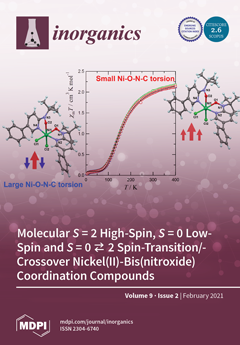The equilibrium geometry and two measures (the equilibrium dissociation energy in the complete basis set limit,
De(CBS) and the intermolecular stretching force constant
kσ) of the strength of the non-covalent interaction of each of six Lewis acids M–X (M
[...] Read more.
The equilibrium geometry and two measures (the equilibrium dissociation energy in the complete basis set limit,
De(CBS) and the intermolecular stretching force constant
kσ) of the strength of the non-covalent interaction of each of six Lewis acids M–X (M = Cu, Ag, Au) with each of nine simple Lewis bases B (B = N
2, CO, HCCH, CH
2CH
2, H
2S, PH
3, HCN, H
2O, and NH
3) have been calculated at the CCSD(T)/aug-cc-pVTZ level of theory in a systematic investigation of the coinage–metal bond. Unlike the corresponding series of hydrogen-bonded B⋯HX and halogen-bonded B⋯XY complexes (and other series involving non-covalent interactions),
De is not directly proportional to
kσ. Nevertheless, as for the other series, it has been possible to express
De in terms of the equation
De =
cNB.
EMX, where
NB and
EMX are the nucleophilicities of the Lewis bases B and the electrophilicities of the Lewis acids M–X, respectively. The order of the
EMX is determined to be
EAuF >
EAuCl >
ECuF >
ECuCl >
EAgF ≈
EAgCl. A reduced electrophilicity defined as (
EMX/σ
max) is introduced, where σ
max is the maximum positive value of the molecular electrostatic surface potential on the 0.001
e/bohr
3 iso-surface. This quantity is, in good approximation, independent of whether F or Cl is attached to M.
Full article





